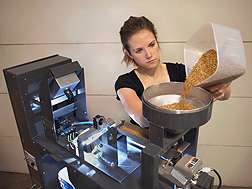Savvy seed sorter separates good from bad

Fast, portable, and comparatively inexpensive, an improved seed-sorting machine developed by aU.S. Department of Agriculture (USDA) scientist and an industry colleague is helping plant breeders and others separate the seeds they want from those they don't, with an impressive degree of accuracy.
Agricultural Research Service (ARS) agricultural engineer Thomas C. Pearson developed the sorter in collaboration with National Manufacturing in Lincoln, Neb. The company has marketed the device to plant breeders and other customers in the United States and abroad since 2010. ARS is the chief intramural scientific research agency of USDA.
The compact, portable sorter is a simpler and faster version of other machine-vision equipment that Pearson developed earlier, and is proving its versatility. According to Pearson, it is being used to separate unwanted grass seeds from seeds of native plants needed to revegetate publicly owned lands in the western United States, for instance.
What's more, a major breeder of peas and beans for vegetable farms uses the machine to remove damaged seeds. Some university plant breeders rely on the sorter to discern and discard spotty peas or to reject wheat kernels that show coloration associated with Fusarium head blight, a costly disease of wheat and barley.
That's not all. In tests in his laboratory at the ARSCenter for Grain and Animal Health Research in Manhattan, Kan., Pearson showed that the sorter can help wheat breeders by differentiating kernels of hard red wheat from kernels of hard white winter wheat, with 98.6 percent accuracy.
In other tests, the sorter was accurate 94 percent of the time in separating yellow from brown flax seed. Sorting is critical because the two are used for different purposes, Pearson explains.
Sorting begins when seeds, placed in a vibrating hopper, start sliding down any of three adjacent chutes. After a seed falls off the end of its chute, a color camera, equipped with an image sensor (a complementary metal-oxide semiconductor, or CMOS) snaps an image and sends it, via a circuit board, to a chip for processing.
The chip uses pre-programmed data to determine whether the seed's surface texture and red, green, and blue color values more closely match those of an "accept" seed than those of a "reject." Seeds that appear similar to "rejects" are quickly directed, via a puff of air from an air valve, into the "reject" container, while the desirable seeds fall neatly into the "accept" bucket.
Pearson has documented his work in peer-reviewed articles published in Applied Engineering in Agriculture, Computers and Electronics in Agriculture, and the Journal of Food Measurement and Characterization. His studies are highlighted in the July 2013 issue of Agricultural Researchmagazine.
Journal information: Agricultural Research
Provided by Agricultural Research Service

















